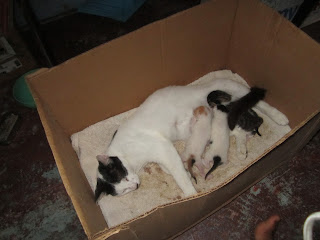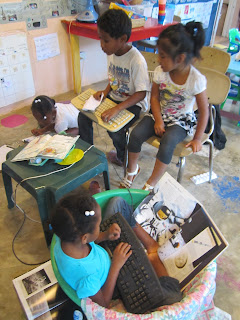One of the most amazing things that I have seen in my life, both from the perspective of a human and a teacher is a child learning how to read. At this point in the year a few of the Kindergarteners are putting the pieces together and starting to sound out words. As lifelong book lover this is a gift to see.

My teaching philosophy is that the teacher is a guide. I provide resources, a literacy rich environment and support for the children to explore their interest in letters. It is my hope that they will learn to read because they want to. The relationship of a child to reading lasts a lifetime and their introduction to literacy is very important. It makes sense that they will not enjoy reading as much if they are forced to learn how before they are ready (as is being pushed more and more today in the states with standardized testing and "drilling," young children). Most children have a natural inclination to explore and learn and when the child is developmentally ready to start reading and writing they often will, as long as they are in a supportive and literacy rich environment and there are not other issues present. Luckily at LTIS the natural learning progression in children is respected and we have the freedom to teach in this organic way.
Here are some aspects of literacy that we have been working on throughout the year:
Reading is one of the best things you can do with a child. Awareness of books and the written word as well as interest in stories is a hallmark of the pre-literacy stage of learning and lays the foundation for future reading, writing and oral communication skills. Each morning at group time we read and discuss a story formally and later in the day we read more stories, often related to the curriculum or an activity.
During morning and afternoon free play students can read independently in the cozy reading corner, exploring texts on their own or with the help of a teacher. We change the book selection to correspond with the curriculum and stories that we read at group.
During pre-literacy stages the children often look at pictures, recognize letters or tell their own stories, using context clues like pictures- all skills they employ later when they begin to read.
Since the beginning of the year many of the objects in the classroom have been labelled so that students begin to notice letters and the relationships between words, objects and meaning. We incorporate literacy rich materials such as magazines, menus, books, vocabulary flashcards, keyboards and writing materials into dramatic play scenarios as well. This motivates children to explore reading and writing in a context that they can relate to while giving them experience reading and writing for a purpose.
Since the beginning of the year we have been familiarizing the class with the alphabet, letters and the sounds of letters with songs, rhymes and games. The class is very interested in practicing writing their letters and came up with the idea to make their own alphabets.
After making our alphabets the class decided we should hang them on the wall next to our writing center so that we could refer to them while we were writing or "if we got confused about what a letter looked like."
We write sentences about the different subjects and vocabulary we are learning about. In terms of second language acquisition it is best to use the sentence structure to model the language and word order. Below, when we were learning about times of the day we wrote "the sun is in the sky in the day," and "the moon is in the sky at night." During group once a week we introduce new sight words (short word like a, I, in, and the) to our wall and try to recognize them when we read books and write sentences. Sometimes the students sound out the words themselves and sometimes they copy a sentence that they came up with that the teacher wrote out.

The class loves to be "profesora," teaching the other students how to read and write words. When the children are writing on their own we use invented spelling. This meand that they write the letters that they hear when they are saying the word and we don't tell them that what they wrote is spelled wrong. Especially when learning a language where there are complicated spellings like English, it is best for students to come up with their own framework of sounds (phonemes) for each letter so that they can problem solve to work out how they think words are spelled. Think about it- if you are operating on letter sounds then hair could actually be spelled "hayr" and face, "fays." As the children learn more they will incorporate new sounds (th, ai, ce and ch for instance) and later words (know) into their framework. It is beneficial for them to continue to experiment and enjoy working with words and letters.

A new project we started recently is our word and letter folders. Each child has a special clear folder that they created during group activity time with their name. During activity or free time they can add letters, letter sounds and words that they have learned to their folder. It gives them a sense of ownership over their learning and allows them (and their teacher) to see how much they are learning, what they know and what they need to work on.
The folders are always available to add to.
The children can add letters and words independently and determine what they would like to learn so that they can add it to their folder.
If one student knows a letter, word or sound they feel proud and often teach what they have learned to their classmates.
The class really enjoys "reading," to the group. Here we are pretending to be teachers and taking turns reading to the class.
Asking each other questions about the text. "What is your favorite animal?"
It is so much fun to see the class taking their own initiative and exploring literature and writing during independent time, free play and teacher led activities. I am constantly impressed by the knowledge of letters, sounds and words that they display and cannot wait to see the progress we make in the last few months of the schoolyear.































































